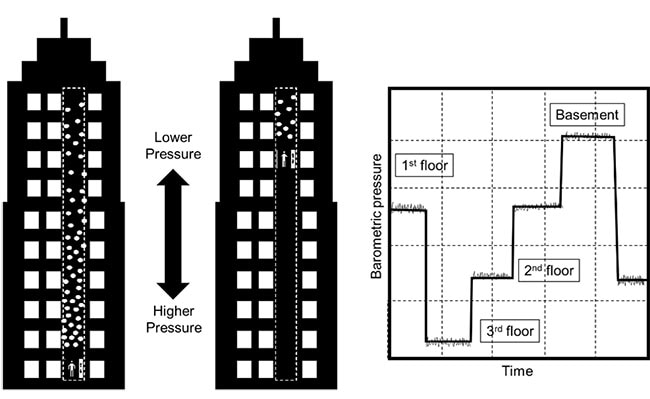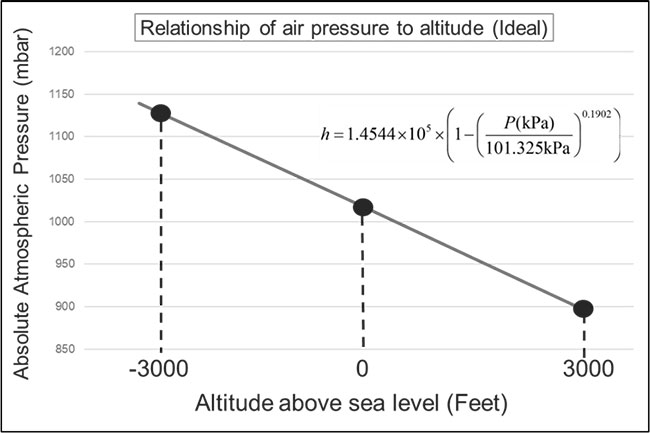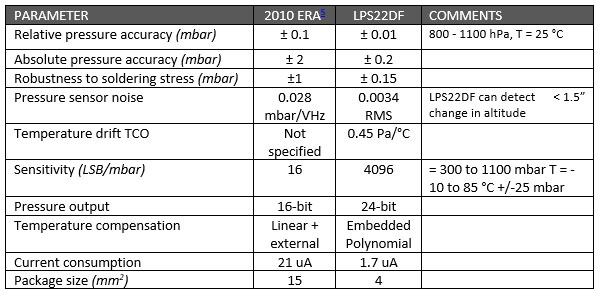Ray Baum Act and E911
In March 2018, the United States Congress passed the RAY BAUM’S Act with a goal to ensure that emergency services can rapidly respond, whether the caller uses a landline, cellphone, VoIP, or other technologies. As of 2022, the FCC (Federal Communications Commission) also adopted guidelines and metrics with a goal to provide floor-level data for E911 calls1. The impact of these regulations is that companies that make phones, tablets, smartwatches, and other voice-capable products are now migrating to incorporate more accurate pressure sensors, which can detect changes in altitude by measuring the air pressure.
Air pressure vs altitude
Air pressure has a direct relationship with altitude. Simply put, the thicker the air mass above us, the higher the pressure exerted upon us. Utilizing pressure sensors for floor detection is commonly associated with building automation and elevator systems.
 Figure 1: Relationship of air pressure to floor levels. (Image source: STMicroelectronics)
Figure 1: Relationship of air pressure to floor levels. (Image source: STMicroelectronics)
The sensors measure changes in air pressure as elevators move between floors. As the elevator goes up, the air pressure decreases because there is less atmosphere above the sensor.
The challenges of meeting the new requirements
For small changes in altitude the relationship between air pressure and altitude is linear, as shown in Figure 2. In ideal conditions at room temperature, the pressure changes by about 1 mbar for every 25.8 feet, or roughly 0.5 mbar per floor in a typical hi-rise building.
 Figure 2: Relationship of air pressure to altitude. (Image source: STMicroelectronics)
Figure 2: Relationship of air pressure to altitude. (Image source: STMicroelectronics)
But in practice, there are two main challenges to using air pressure for floor-level detection. First, sensor accuracy across the operating range of pressures and temperatures, and secondly how to compensate for pressure variations due to local conditions such as weather, temperature, air turbulence, and so on.
Sensor Accuracy
During the past decade, MEMS pressure sensors have made significant strides towards improving accuracy and stability over all the operating conditions. Pressure sensors are now equipped with embedded temperature compensation, and chip manufacturers have ramped up the factory calibration operations to improve the accuracy and stability of pressure sensors over time and temperature.
This is highlighted in Table 1, which contrasts earlier MEMS pressure sensors to today’s state-of-the-art LPS22DF absolute pressure sensor:
 Table 1: Key parameters of legacy to modern pressure sensors.
Table 1: Key parameters of legacy to modern pressure sensors.
The LPS22DF features an advanced MEMS design that significantly reduces the drift and accelerates the recovery after soldering. Additionally, the LPS22DF’s design provides long-term stability by limiting the drift over time. Modern pressure sensors such as LPS22DF can reliably detect changes in floor level.
Local weather
Weather conditions, especially daily changes in temperature and humidity, can significantly affect the atmospheric air pressure. On any given day the barometric pressure can change by the equivalent of several floor levels in just a few hours. In the example below, the barometric pressure change of 3 mbar is equivalent to more than 78-foot change in altitude.
 Figure 3: Hourly atmospheric pressure in New York City4. (Image source: https://barometricpressure.app/new-york)
Figure 3: Hourly atmospheric pressure in New York City4. (Image source: https://barometricpressure.app/new-york)
Weather and local pressure compensation
Compensating for weather involves the implementation of calibration and continuous adjustment of the pressure readings based on real-time atmospheric pressure data.
 Figure 4: Calibration and compensation for changing weather conditions. (Image source: STMicroelectronics)
Figure 4: Calibration and compensation for changing weather conditions. (Image source: STMicroelectronics)
Companies like NextNav3 offer sophisticated algorithms and sensor fusion techniques to compensate for external factors. Nextnav’s Pinnacle® is a system offering which provides precise, “floor-level” vertical positioning for geolocation applications by leveraging the barometric sensors. The company has also deployed a fleet of managed servers and reference stations covering entire metropolitan areas, providing comprehensive z-axis coverage in urban settings.
Nextnav is also working to improve the quality and accuracy of barometric pressure sensors through a “NextNav Certified” program. Working in conjunction with device manufacturers, NextNav will develop a test plan specific to the sensor model and assess the test results based on the agreed-upon framework. After the final certification, Nextnav issues a letter of certification to prove compliance with NextNav Certified standards. Thanks to significant improvements in absolute accuracy and low-drift architecture, LPS22DF is ST’s first pressure sensor to receive the NextNav Certification2.
Conclusion
As of 2022, regulators have mandated that, all voice-capable systems must meet the requirements set by the RAY BAUM’S Act and the FCC. Equipment makers of phones, tablets, smartwatches, and other voice capable IoT products are integrating more accurate pressure sensors to meet the new standards. Third party companies such as NextNav offer certification services as well as software and hardware solutions to achieve the required vertical accuracy. In addition to services such as Enhanced 911, there are many other applications which will take advantage of these new hardware and software capabilities.
References
- Dispatchable Location for 911 Calls: https://www.fcc.gov/911-dispatchable-location
- LPS22DF, ST’s first pressure sensor to receive the NextNav Certification thanks to unique capabilities: https://blog.st.com/lps22df-nextnav/
- NextNav adds new dimensions to geolocation : www.nextnav.com
- New York Barometric Pressure Forecast and History: https://barometricpressure.app/new-york
- LPS001WP & LPS331AP barometric pressure sensors: LPS001WP - MEMS pressure sensor, 300-1100 mbar absolute digital output barometer - STMicroelectronics

Have questions or comments? Continue the conversation on TechForum, Digi-Key's online community and technical resource.
Visit TechForum





